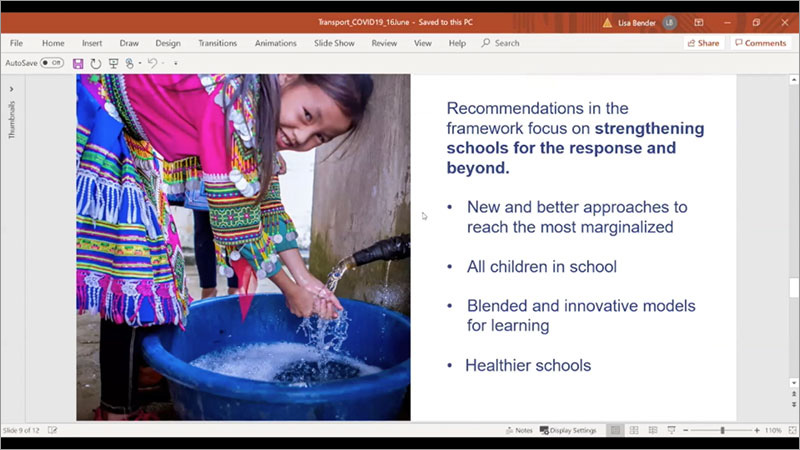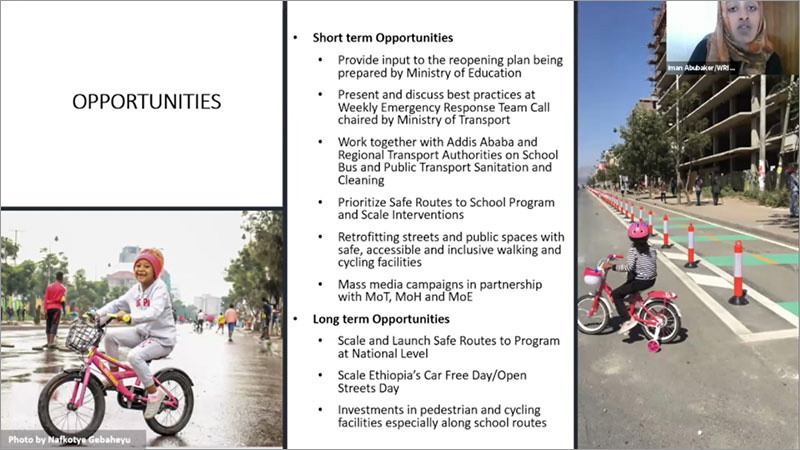CHI & UNICEF to release guidance on safe, healthy journeys to school during COVID-19




Protecting 1.7 billion children as they venture back to school during the COVID-19 pandemic is not just possible, but a long-term opportunity, said speakers and participants of the Child Health Initiative’s online meeting, convening more than 60 global mobility experts.
At the heart of this, and every crisis, is the potential for opportunities to build back better, argued UNICEF’s Lisa Bender as she highlighted the organization’s aim to build global citizenship and find ways to not only engage children, but also strengthen their voices through the process. Acting on the once in a lifetime opportunity to do things differently and embed messages around children and education, UNICEF produced a framework document for reopening schools and supporting national decision making.
To ensure the safest, healthiest journeys to school possible during the pandemic, UNICEF invited the Child Health Initiative to create supplementary, broad, illustrative guidance that can be applied in a variety of settings, but focus on low- and middle- income countries. It will complement and be integrated into UNICEF’s global framework and interim guidance on how schools can safely reopen.
To inform the guidance, participants discussed the future of children’s journeys and the implications of the COVID-19 crisis on sustainable mobility. Speakers included UNICEF representatives Raoul Bermejo and Lisa Bender, Mirjam Sidik of the AIP Foundation, Iman Abubaker of WRI Africa and Gashaw Tenna, Senior Adviser to the Ethiopian Minister of Transport.
With perspectives from Latin America, Africa, and Asia, the discussion was a follow-up to the FIA Foundation’s online meeting about safe and sustainable mobility post COVID-19 and centred around five themes: Delivering long-term positive change; inclusivity; engaging policymakers; improving air quality; and securing funding. The summary can be found here.
Speakers discussed how many low-cost solutions to increase walking and cycling to school already exist, and can be found in the Child Health Initiative toolkit. Others have emerged: in Ethiopia parking lots are repurposed for play; in Vietnam school zones reduce speed for distances drop-offs; while the US is exploring remote drop-off locations and street closures around schools. Implementing speed management solutions in particular can help protect children as they return to school, and ensure that safer, healthier journeys are here to stay.
Building back better also means ensuring the journey to school is inclusive. A tenth of students around the world live with disabilities and many struggle to reach school even when there isn’t a pandemic – leading discussions to centre on how to ensure opportunities can be more, not less, available.
A handful of success stories are all that is needed to build the political buy-in for change, said participants. Prior to the pandemic, Nani Rodriguez of Fundación Gonzalo Rodriguez explained their strategy to create policy change by targeting policymakers directly, rather than starting from grassroots. Collaboration and communication within and across borders is key, agreed participants, as well as a willingness to adapt as the pandemic evolves and more effective solutions emerge.
The journey to school poses more than the risk on the ground – the air children breathe each day can, and does, kill. Particulates have a particularly severe impact on children, said Carly Gilbert-Patrick of UNEP, and the reduction of vehicles on the roads offers the chance for a fresh start, by focusing public attention on dirty air. Air quality monitoring can demonstrate the impact of mobility decisions and support advocacy for cleaner vehicles and streets.
As cities review their budgets, there is an opportunity to emphasize that investing in safe and healthy journeys to school will not only help children go back to school, but will also help achieve physical distancing for the wider population. The international road safety community will need to find creative ways to secure funding for safe and healthy journeys as we build back better in the face of reduced budgets and economic uncertainty. Emphasizing how interventions are connected to larger goals and seeking other funding sources such as multilateral banks will be key.
Natalie Draisin, North American Office Director of the FIA Foundation and UN Representative, said: “We have an opportunity to address all safety issues at the crossroads of mobility. There is such a wealth of experience and goodwill, which we must turn to action. That is why participation in these discussions is crucial as it feeds directly into guidance that will be shared at the highest levels of governance around the world, giving our children a real chance for a brighter future.”
To learn more, visit our meeting summary, including the recording here.







